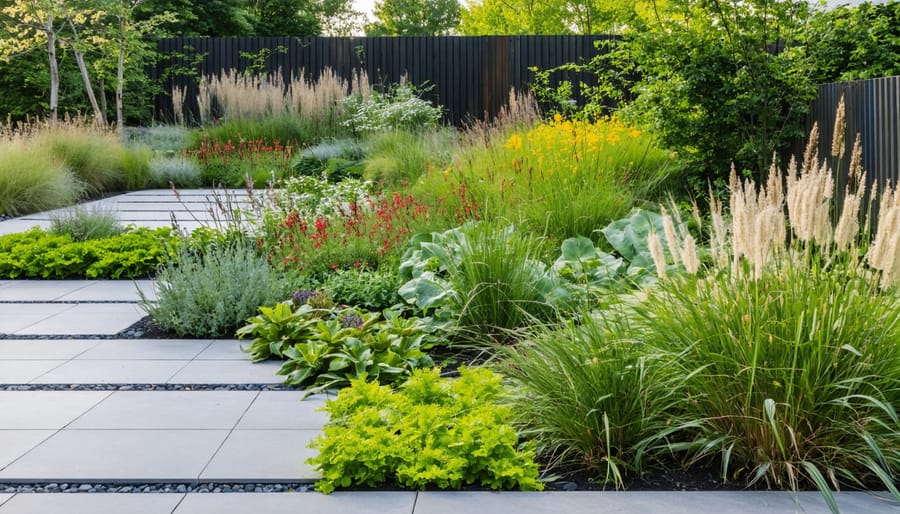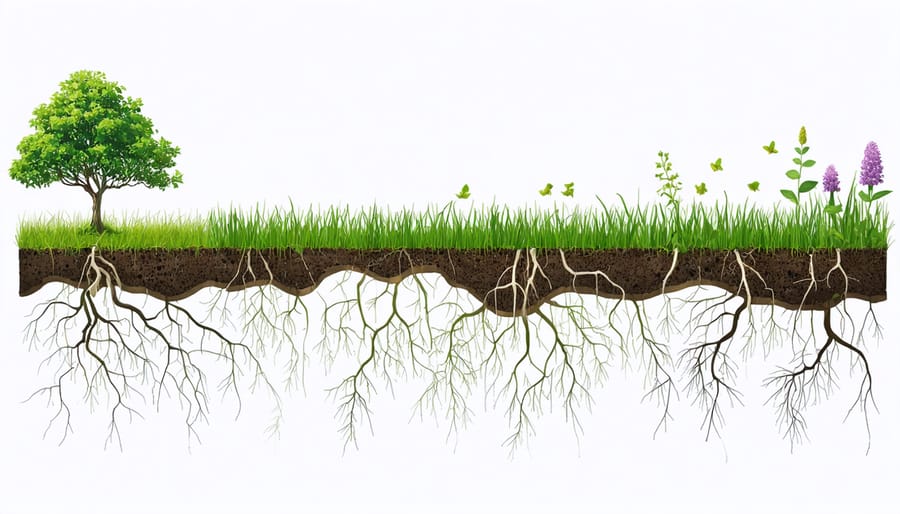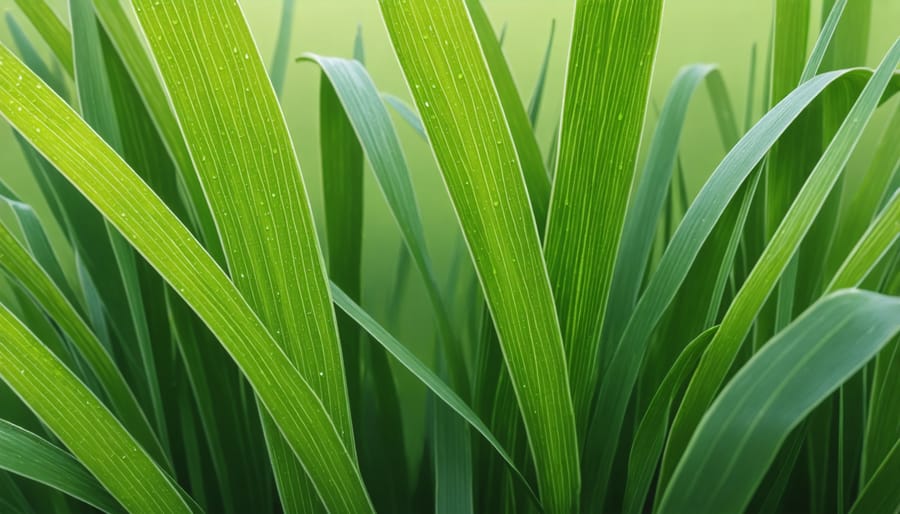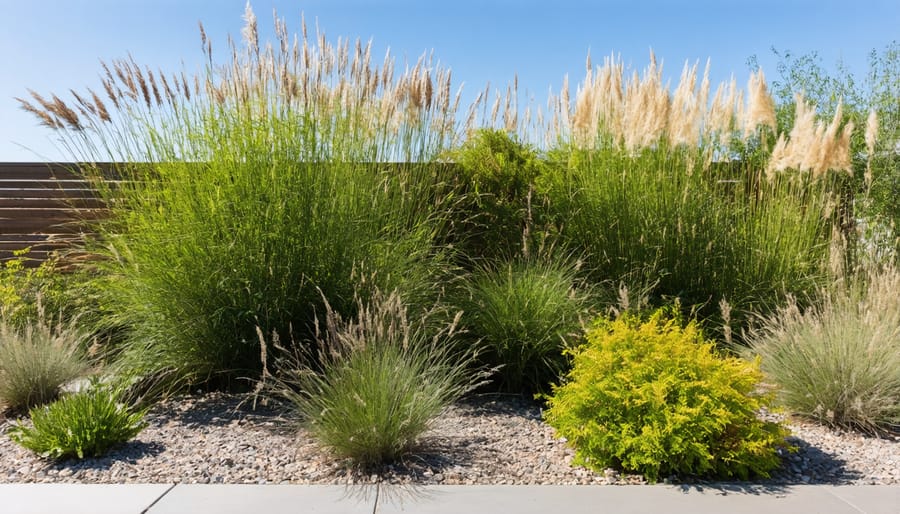Tough Plants That Thrive: Smart Grassland Choices for Your Weather-Resistant Landscape

Transform your garden into resilient low-maintenance landscapes by harnessing the remarkable adaptations of grassland plants. These prairie-inspired species have evolved deep root systems that can reach up to 15 feet underground, making them exceptionally drought-resistant and perfect for water-wise gardening. Their specialized leaf structures – including rolled edges, waxy coatings, and silver-gray coloring – minimize moisture loss while creating striking visual interest. Native grasses like Little Bluestem and Prairie Dropseed, along with hardy perennials such as Coneflowers and Black-Eyed Susans, showcase these adaptations brilliantly in modern gardens. Understanding and implementing these natural survival strategies allows homeowners to create stunning, sustainable landscapes that thrive with minimal intervention, even in challenging climate conditions.
Why Grassland Plants Make Perfect Sense for Your Yard
Built-in Climate Defense
Grassland plants have evolved remarkable defenses against nature’s extremes, making them excellent choices for weather-resistant landscaping. Their deep, extensive root systems act like natural anchors, helping them stay firmly planted during strong winds and storms. Many species develop waxy coatings on their leaves that seal in moisture and protect against harsh sun exposure, while others feature tiny hairs that reflect sunlight and reduce water loss through evaporation.
These plants are particularly adept at handling temperature swings. Some varieties can curl their leaves inward during extreme heat or cold, creating a protective microclimate around their most sensitive parts. Others maintain dormant buds at or below ground level, allowing them to regenerate quickly after fires or freezes.
Perhaps most impressively, grassland plants often grow in tight clusters, creating natural windbreaks and sharing resources through their interconnected root systems. This community approach to survival makes them particularly resilient in challenging weather conditions, and it’s one reason why they’re increasingly popular in modern, climate-conscious landscaping designs.
Low Maintenance, High Impact
One of the most appealing aspects of grassland-adapted plants is their inherent low-maintenance nature. These hardy species have evolved to thrive with minimal human intervention, making them perfect for busy homeowners. Once established, they typically require less watering than traditional landscape plants, saving both time and money on irrigation. Their deep root systems help them access water and nutrients independently, reducing the need for frequent fertilization.
Despite their minimal care requirements, these plants deliver stunning visual impact throughout the seasons. Many prairie species offer dramatic height variations, creating natural layers in your landscape. From tall switchgrass swaying in the breeze to compact wildflowers dotting the ground, they provide year-round interest. The changing colors of native grasses – from spring greens to autumn golds and russets – create a dynamic landscape that evolves naturally with the seasons. Even in winter, their dried stalks and seed heads add architectural interest while providing food for local wildlife.
Key Adaptations That Make Grassland Plants Tough
Deep Root Systems
Grassland plants have evolved remarkable root systems that often extend deeper into the soil than the visible plant above ground. These extensive root networks are a crucial adaptation that enhances drought resistance and helps maintain soil stability in challenging conditions. Some prairie grasses can develop roots reaching depths of 15 feet or more, allowing them to access water sources far below the surface.
These deep roots serve multiple purposes in your landscape. They help prevent soil erosion by creating a dense underground network that holds soil particles together, making them excellent choices for slopes or areas prone to washing out. During dry spells, deep-rooted plants can continue thriving when shallow-rooted plants struggle, reducing the need for supplemental watering.
For homeowners, incorporating deep-rooted prairie plants like Big Bluestem or Switch Grass into your landscape design can improve soil structure and reduce maintenance needs over time. These root systems also enhance soil health by adding organic matter as older roots decay, creating natural channels for water infiltration, and supporting beneficial soil microorganisms.

Specialized Leaves and Stems
Grassland plants have evolved remarkable leaf and stem features to thrive in challenging conditions. Many species develop thick, waxy coatings on their leaves that act like natural moisture barriers, preventing water loss through evaporation. These specialized leaves often roll inward during hot, dry periods, creating a protected microclimate that helps retain precious moisture.
Some plants feature small, narrow leaves that reduce surface area exposure to intense sunlight and hot winds. Others have developed silvery or hairy leaf surfaces that reflect sunlight and trap a layer of humid air close to the leaf, helping to regulate temperature and moisture levels.
The stems of grassland plants are equally well-adapted. Many species have developed underground stems called rhizomes that store water and nutrients, allowing plants to survive extended dry periods. These stems also help plants spread horizontally, creating dense root networks that stabilize soil and protect against erosion.
Some plants even modify their stems to store water, developing thick, succulent tissues that act as natural reservoirs during drought conditions. These adaptations make grassland plants particularly resilient and perfect for low-maintenance, drought-resistant landscaping.

Growth Patterns
Grassland plants have developed remarkable growth patterns that help them thrive through changing seasons and challenging conditions. Many species grow rapidly during favorable periods, storing nutrients in their roots for tougher times ahead. These plants often feature dense, low-growing habits that protect them from harsh winds and help conserve moisture.
During drought periods, some grassland plants can go dormant, essentially “sleeping” until conditions improve. When rain returns, they bounce back quickly, showing impressive recovery rates. This stop-and-start growth pattern makes them particularly resilient in areas with unpredictable rainfall.
Most grassland plants concentrate their growth near the ground, with extensive root systems that can regrow even after severe damage from grazing or fire. This adaptation ensures survival and explains why these plants make excellent choices for low-maintenance, sustainable landscapes.
Top Grassland Plants for Your Climate-Smart Garden
Sun-Loving Champions
Grassland plants are true champions when it comes to soaking up the sun, having evolved perfect strategies for thriving in bright, open conditions. These sun-loving specimens typically feature small, narrow leaves that minimize water loss while maximizing light absorption. Many develop a silvery or gray-green color that reflects excess sunlight, preventing leaf burn during intense afternoon heat.
Common examples include butterfly weed, which pairs its sun-loving nature with stunning orange blooms that attract pollinators, and little bluestem grass, whose blue-green summer foliage turns a striking copper-red in fall. Black-eyed Susans showcase their ability to handle full sun with cheerful yellow flowers that bloom for weeks, while purple coneflowers stand tall and proud even during the hottest summer days.
These plants often develop extensive root systems that reach deep into the soil, allowing them to access water reserves during dry spells. Their upright growth habits help them avoid shading each other out, ensuring each plant gets its fair share of sunlight. For homeowners looking to create low-maintenance, drought-resistant gardens, these sun-loving champions offer the perfect combination of resilience and beauty, providing reliable color and structure throughout the growing season.
Drought-Ready Varieties
Drought-ready varieties are nature’s answer to water scarcity, equipped with remarkable features that help them thrive in dry conditions. These resilient plants typically have deep root systems that can reach further into the soil to access hidden water reserves. Many feature silvery or gray-colored foliage that reflects sunlight and reduces water loss through evaporation.
Popular drought-resistant options include Blue Fescue, which forms attractive clumps with blue-gray leaves, and Little Bluestem, known for its upright growth and stunning fall colors. Buffalo Grass has become a favorite among homeowners for its ability to maintain a lush appearance with minimal watering, while Purple Coneflower adds vibrant color while staying tough through dry spells.
These varieties often develop waxy coatings on their leaves and stems, which act like natural moisture barriers. Some also have small, narrow leaves that minimize water loss through transpiration. What makes these plants particularly appealing for modern landscapes is their ability to maintain visual appeal while requiring significantly less maintenance and water than traditional turf grass.
For best results, group drought-ready varieties together in your landscape to create water-efficient zones that share similar moisture needs.

Planning Your Grassland-Inspired Landscape
Creating a grassland-inspired landscape starts with understanding your yard’s conditions. Begin by assessing your soil type, sun exposure, and local climate patterns. Most grassland plants thrive in full sun and well-draining soil, making them perfect for open areas of your yard.
Start small by designating a specific area for your prairie garden. Group plants in clusters of odd numbers (3, 5, or 7) to create a natural, flowing appearance. Consider incorporating both tall grasses as background elements and shorter flowering plants in the foreground for visual interest.
Layer your plantings by height, with the tallest species at the back or center of your design. Include a mix of cool-season and warm-season grasses to ensure year-round interest. Add native wildflowers that complement the grasses and provide food for pollinators.
For maintenance, remember that grassland plants typically need minimal watering once established. Plan for annual spring cleanup and occasional division of spreading plants. Leave dried grasses standing through winter for visual interest and wildlife habitat.
When selecting plants, choose species that match your region’s rainfall patterns. Consider creating meandering pathways through your grassland garden to make it more interactive and accessible for maintenance. Remember to check local regulations regarding grass height and maintenance requirements before finalizing your design.
By incorporating grassland plant adaptations into your landscape, you’re not just creating a beautiful yard – you’re building a resilient, sustainable outdoor space that thrives in challenging conditions. These remarkable plants offer numerous benefits, from reduced water consumption and maintenance needs to increased wildlife habitat and natural beauty. Whether you’re drawn to the graceful movement of ornamental grasses or the vibrant blooms of prairie flowers, climate-adaptive landscaping with grassland species is a smart choice for modern homeowners. Start small by incorporating a few adapted plants into your existing landscape, and watch as your yard transforms into a dynamic, eco-friendly haven that stands the test of time while requiring less effort to maintain.

